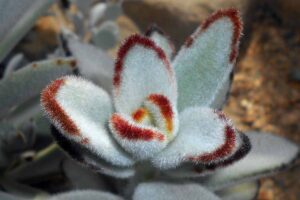Euphorbia spp.
My first experience with euphorbias was the weedy, impossible-to-eliminate spurge weed, Euphorbia maculata.
The stuff is so obnoxious, I thought I was ready to write off the entire genus. Good thing I didn’t, because it contains some exceptional plants!

We link to vendors to help you find relevant products. If you buy from one of our links, we may earn a commission.
There are massive, tree-like Euphorbia species that grow nearly 100 feet tall, and itty-bitty ‘Tiny Tim’ spurge that stays under a foot.
Some emerge in late winter, and others stick around well past the first frost. Most are sun lovers that don’t mind a little neglect.
Generally, euphorbias are tough, easy to care for, drought tolerant, and vibrantly colored, many with acid-green leaves and often colorful floral bracts.
They’re the perfect thing for rock gardens and tough, dry spots. Some can even tolerate heavy soil or shade.
These underappreciated plants deserve a more prominent spot in the garden.
The chartreuse coloring is like a bright light demanding all the attention. Convinced you need some euphorbia in your yard? Good!
Here’s what we’re going to discuss to help you make the most of these eye-catching plants:
What You’ll Learn
Don’t get me wrong, I still detest spurge weed, but the word “euphorbia” no longer sets my teeth on edge.
Now, it brings to mind some exceptionally versatile and tough beauties. Ready to learn more?
Cultivation and History
Euphorbia is a huge genus with around 2,000 known species that vary dramatically in appearance.
And it’s a genus that is constantly changing with new advances in taxonomy, with new species added and others shifted to different genera.
Some look like cacti, with spines (actually thorns) and everything, while others look like herbaceous shrubs or even trees. Some are annuals, others are biennials, and the rest are perennials.
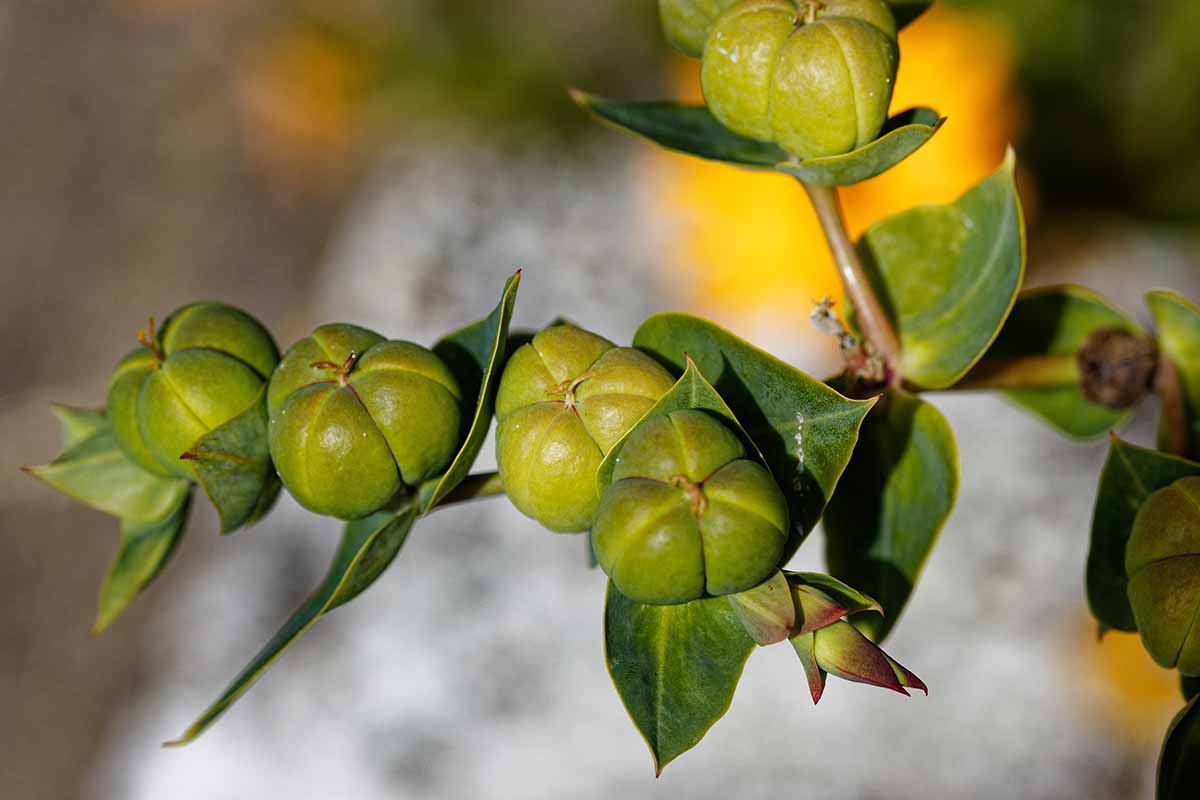
This genus includes poinsettias, Cypress spurge, candelabra tree, and gopher spurge.
What could possibly unite this varied group? They all have a milky latex inside that contains toxic di- or tri-terpene esters.
All have a pseudanthium, which is an inflorescence that is made up of multiple flowers that look like one single flower. These flowers don’t have the sepals and petals that characterize other flowers.
The fruits have three seeds that explode out of the fruit.
A Note of Caution:
The milky latex inside Euphorbia plants is there primarily as a deterrent against omnivores and herbivores.
That means you shouldn’t eat them, and neither should your pets or livestock. Also, the sap can cause skin or eye irritation.
Euphorbia species grow indigenously across the world in warm, dry, and tropical regions. You’ll find them in parts of Africa, China, India, the Americas, Europe, the Pacific Islands, and Australia.
Plants in this genus have been used for centuries medicinally. The latex has been used as a purgative and to kill intestinal parasites.
European caper spurge (E. lathyris) was used as a laxative, and scientists are looking at cancer weed (E. peplus) as a potential treatment for cancer.
There have been many fantastic Euphorbia cultivars and hybrids bred over the years, and the plants hybridize on their own in nature too.
That means there’s an endless supply of options, with something perfect that’s for just about any spot.
Euphorbia Propagation
Divide, grow cuttings, buy plants, or even sow seeds. There are lots of ways to add euphorbias to your garden.
From Seed
Many euphorbias can be grown from seed, but not all. Of those that can be grown from seed, many can be a challenge to germinate.
Some hybrids are either sterile or won’t grow true. On top of that, the seeds can be difficult to harvest, and they don’t last long.
If you want to grow euphorbia from seed, stick to purchasing from a reputable seller that lists the harvest or best-by date on the packaging. Start them indoors about six weeks before the last frost. The seeds need light, nutrient-poor soil to germinate well.
Fill seed trays with cactus potting soil and thoroughly wet the soil. Then, gently press the seeds into the surface.
Sprinkle some potting mix over the seeds, but add no more than twice the thickness of the seeds. Seeds should be spaced about an inch apart.
Remember, these seeds have a short shelf life, and you probably can’t expect more than half to germinate even if you have relatively fresh seeds available. Feel free to sow them closer together with the idea of thinning them out as needed, if you wish.
Place the tray in an area that stays around 75°F or use a seed heating mat to maintain the soil temperature at about that level. Don’t place the seeds in full sun. They should receive bright, indirect light until seedlings have grown cotyledons.
Keep the soil moist but not wet. If you were to wring out a sponge really well, that’s the moisture level you’re aiming for.
From Cuttings
While seeds are an iffy proposition, cuttings are much more reliable, with the added bonus that you can faithfully reproduce the plant you’re cutting from since cuttings are clones with DNA identical to the parent.
On top of that, many euphorbias will become leggy or sprawl over time, and taking cuttings is a good way to force plants back into a nice shape.
Before we get started, grab yourself some gloves. Remember, that latex sap is nothing to mess around with. It can cause serious skin irritation in some individuals.
Wait for the spring to start the work. Branching types should be cut where a branch meets the main stem, and solitary or succulent types should be beheaded.
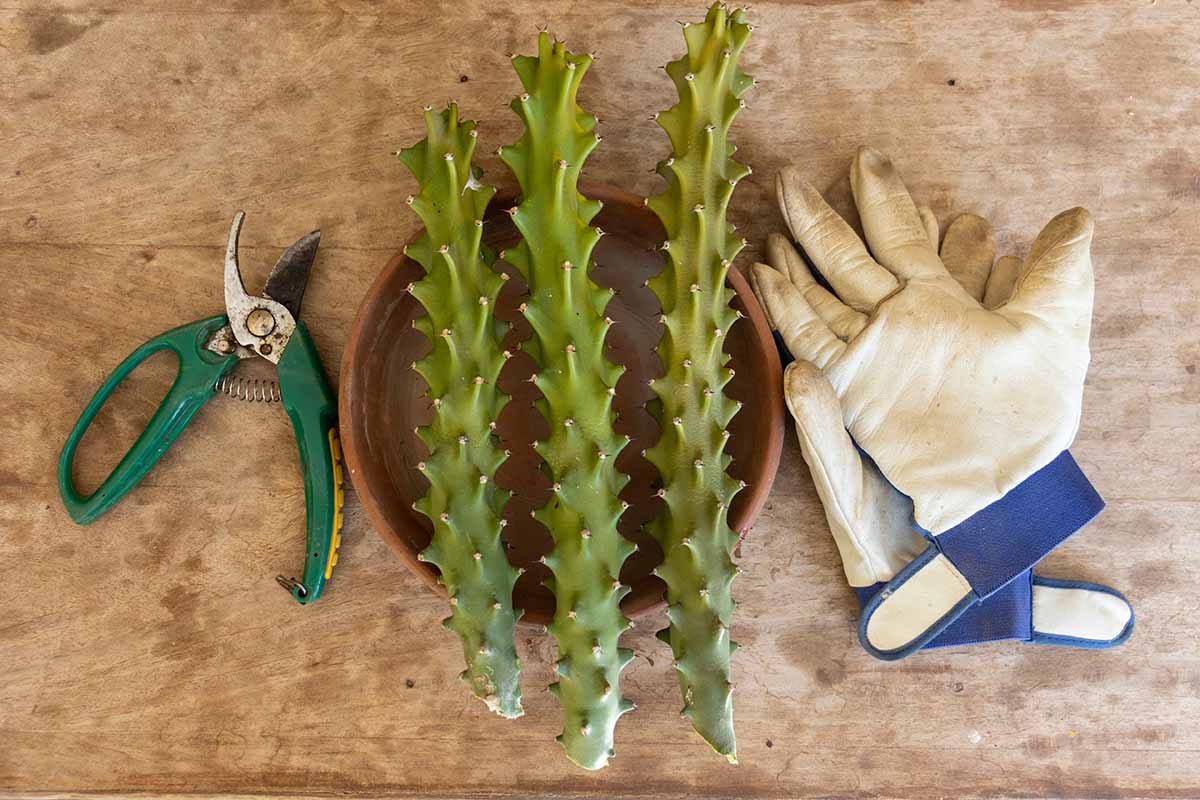
If you’ve never decapitated a succulent before, I find using fishing line or dental floss to be the easiest method for leafy types. Take the dental floss between your two hands and use it to garrote the plant near the base but above the bottom layer or two of leaves.
After you’ve severed the plant, pluck a few more leaves off the bottom section and at the base of the top section to make open spots on the stem where new growth can emerge.
For solitary types, use a knife to cut through the plant about a quarter of the way down.
Either way, when you’re done, use a stream of cold water to wash away the latex from both sides and allow them both to dry to encourage the plant to form a callus.
While the plant is still wet, you can also sprinkle some rooting hormone on the newly exposed area if you want to use it, but it’s not required.
The base of the plant can be allowed to grow as normal. The top part should be set into a moistened cactus mix in a pot large enough to contain the plant section, and gently pressed into the medium.
Remove leaves from the bottom two-thirds of branches and bury them deep enough to stay upright on their own.
Place in an area with bright, indirect light. As with seeds, a soil temperature of 75°F is ideal, so use a heat mat if your home or growing area is cooler than this.
Timing varies widely depending on the environment and species, but generally, new roots should start forming within four weeks or so. If you look at the bottom section and it has new growth, the top cutting should as well.
A gentle tug should tell you if roots have formed since a rooted plant will resist. After a month or so, a cutting that hasn’t rooted will usually show signs of dying back, so it’s easy to tell one way or the other.
Maybe you take a cutting and then you don’t have time to plant it right away? We’ve all done it. If that happens and it starts to dehydrate, you can plop it in a cup of room-temperature water, and it should rehydrate within a few hours or overnight. Plant it right away.
From Divisions
Herbaceous euphorbias can easily be divided. Wait for the spring or fall to start working.
Then, grab a shovel and dig down around the perimeter of the plant. Aim to dig a few inches out from the furthest out leaves.
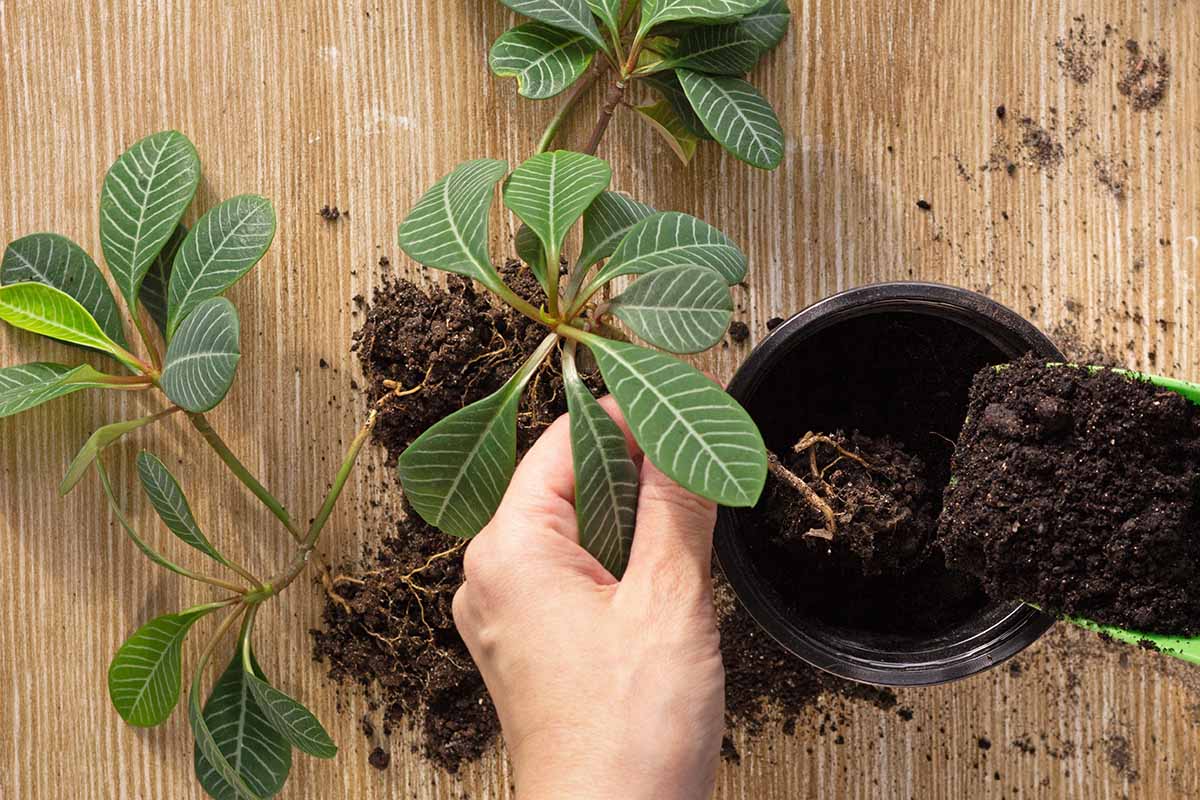
Once you’ve dug around the entire plant, use your shovel to gently lift it out of the ground. Brush or wash away as much of the soil from the roots as you can.
Now, take a pair of scissors or a knife and cut apart a section or two from the plant. You want to include some roots along with a stem or several stems.
Replant the original section, filling in with soil. Plant the divided portions in their own area as described below.
From Potted Plants or Transplants
If you purchase euphorbia plants, start seed indoors, or steal a cutting from your neighbor’s garden, you’re going to have to eventually transfer the plants into their permanent home.
Well, permanent assuming your neighbor doesn’t steal it back, anyway…
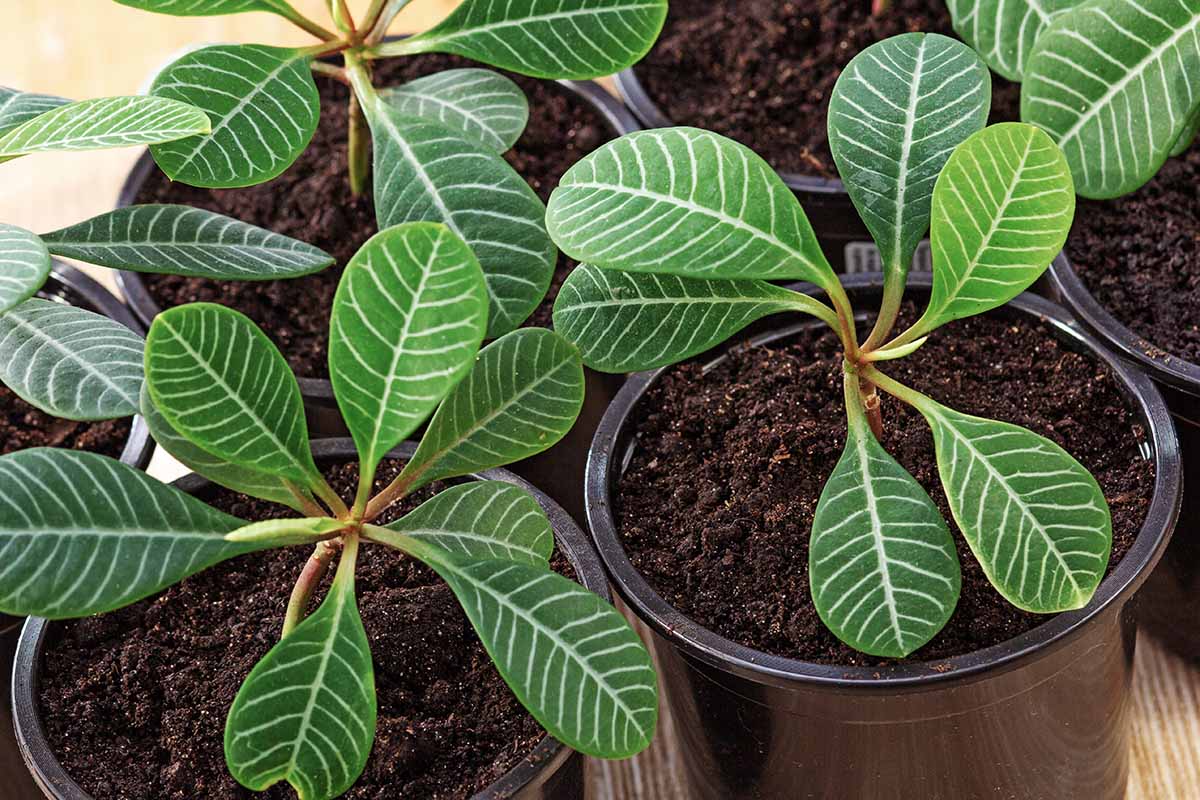
After you’ve picked the right spot, dig a hole that’s just a touch wider and as deep as the container or root ball.
Remove the plant from its container, and lower it into the hole. Fill in around the roots with some of the removed soil so the plant stands upright on its own.
Water and add more soil if it settles.
How to Grow Euphorbia Plants
Given how diverse this genus is, it shouldn’t come as a surprise that the growing requirements for various types of euphorbia vary as well.
Most Euphorbia varieties need full sun, or partial sun with shade in the heat of the afternoon.
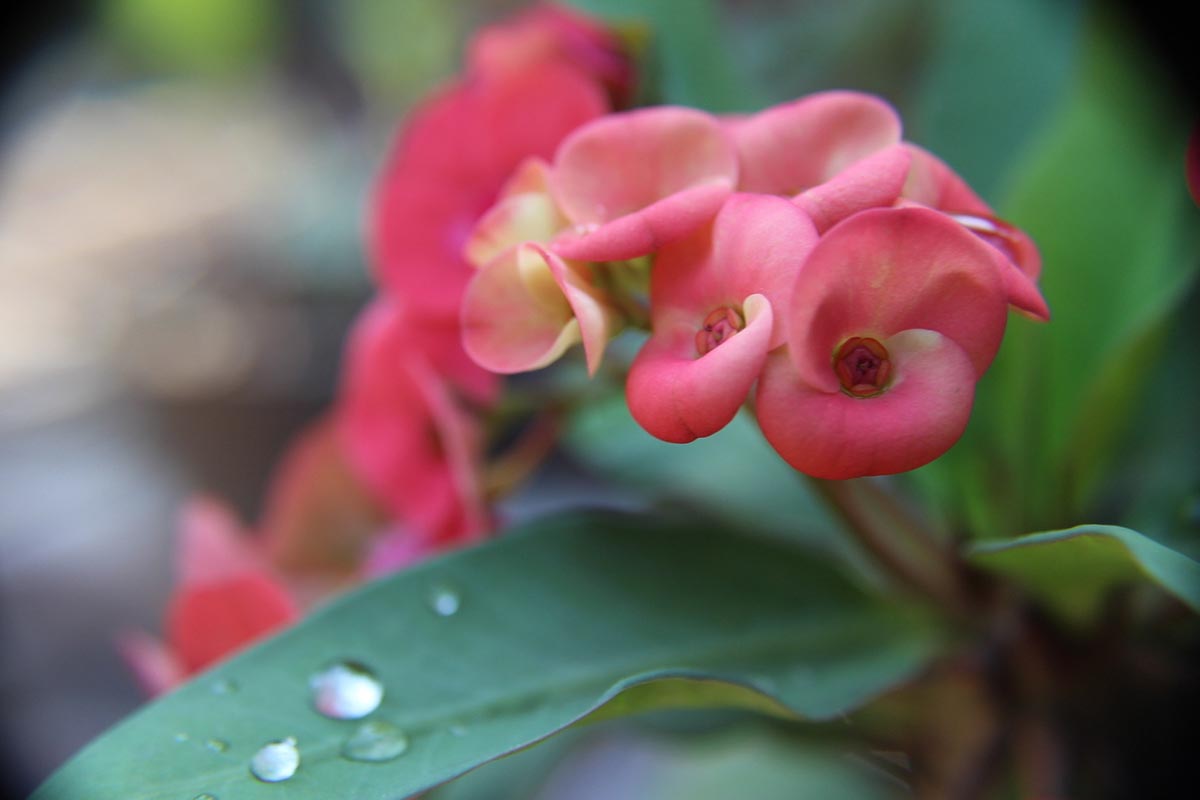
For succulent or semi-succulent types, remember that these aren’t true cacti.
They don’t thrive in the same heat and dry conditions that cacti do. Most species do best with cool roots protected from the sun by rocks.
Euphorbias and clay soil do not get along, with few exceptions. These plants need soil that’s loose enough that they can stretch out their roots and gain a foothold while at the same time not holding onto too much water. Clay is the opposite of that. Sandy or loamy soil is best.
When it comes to water, err on the dry side. But that doesn’t mean you should treat euphorbia like cacti and allow the soil to become parched.
Most euphorbias grow in areas where the soil is only dry occasionally or for part of the year. Many of them obtain lots of moisture from dew or humid air. While most can survive some drought, that doesn’t mean it’s what’s best for them.
During the growing season, soak the soil regularly but infrequently. You want to encourage deep roots.
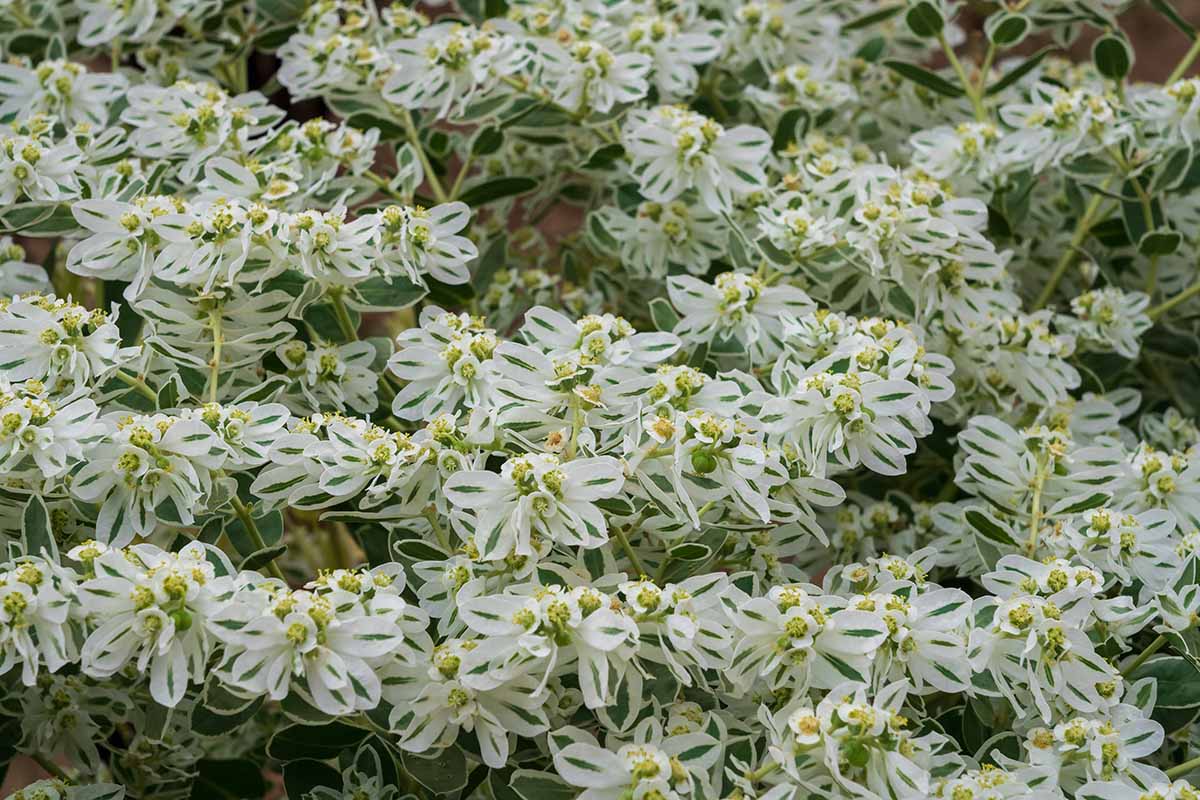
Your watering routine should depend on the size of the plant. A young plant needs more frequent watering than an older one because its roots haven’t grown as deep.
For a mature euphorbia, you can safely allow the top two inches of soil to dry out. For younger plants, never let more than the top inch dry out.
Most Euphorbia species grow in humid areas where they can gather at least some of their moisture from the air. If you have a dry climate, you’ll need to add water more often. Plants exposed to direct sun all day will need more frequent watering as well.
During the growing season, most will benefit from a mild, balanced fertilizer applied at least once in the spring and again in midsummer.
Look for something with an NPK ratio of 3-3-3, 5-5-5, or similar.
Growing Tips
- Most euphorbias need moderately moist to dry soil. Avoid overwatering.
- Know the light requirements for your specific species.
- Most need feeding several times each year with a mild fertilizer.
Maintenance
Most euphorbias don’t need a lot of maintenance. When you do go out to work on your plants, wear gloves. Remember that the milky sap can be a skin irritant.
There are three types of euphorbias when it comes to maintenance: evergreen, deciduous, and biennial.
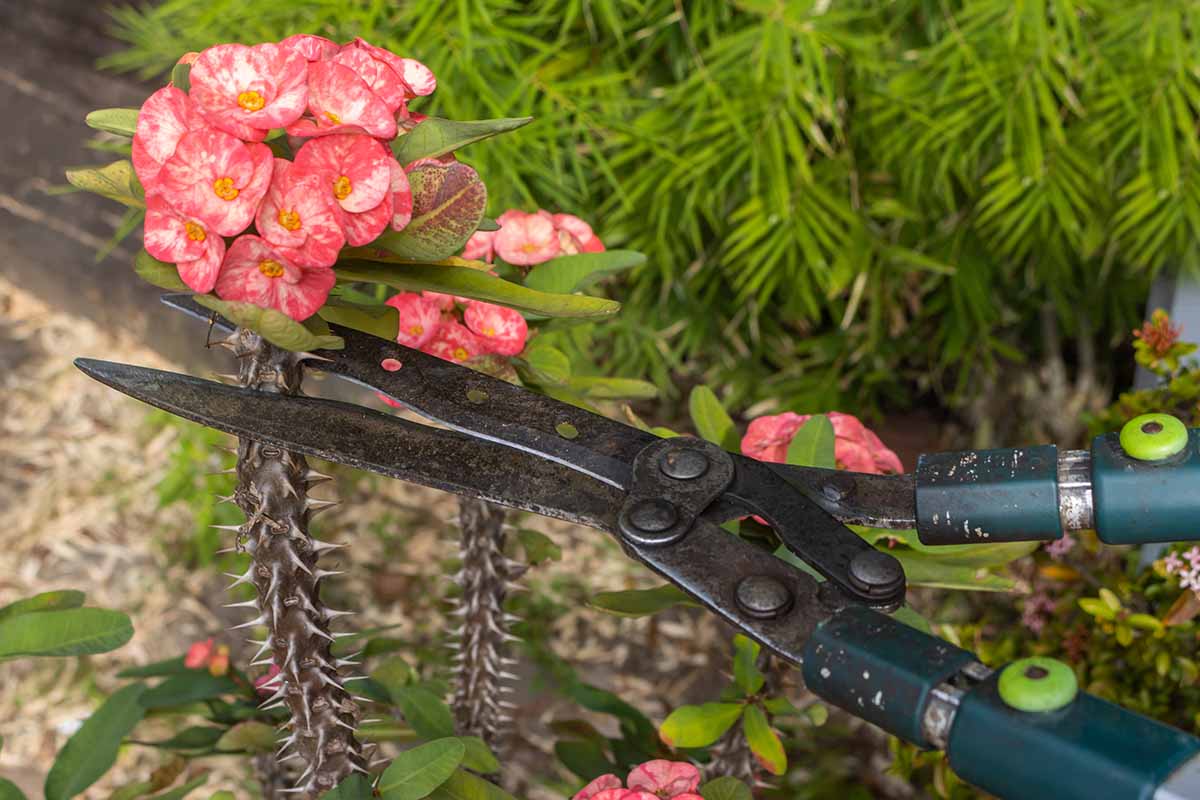
For evergreen euphorbias, just cut off spent flower heads using a clean pair of scissors.
You can also remove any dead or damaged leaves or stems and trim to provide some shape. Otherwise, they don’t need more than that.
Biennial types will flower in their second year. After they flower, you can allow the seeds to drop, but then cut them back to the ground.
For deciduous types, once the frost hits and the leaves turn brown or mushy, cut them back to the ground.
Species and Cultivars to Select
With so many species and hybrids out there, you know there’s going to be a euphorbia that’s right for your garden.
It would take a long time to even scrape the surface with all of these incredible plants, so here are a few interesting options that make excellent houseplants and garden specimens.
Diamond Frost
This sterile hybrid, E. x ‘Inneuphdia,’ is one of the most popular options out there.
It’s tailor-made for hanging baskets or containers, grows up to 18 inches tall and wide, and is smothered in delicate, pure white blossoms that persist throughout the summer without any deadheading.
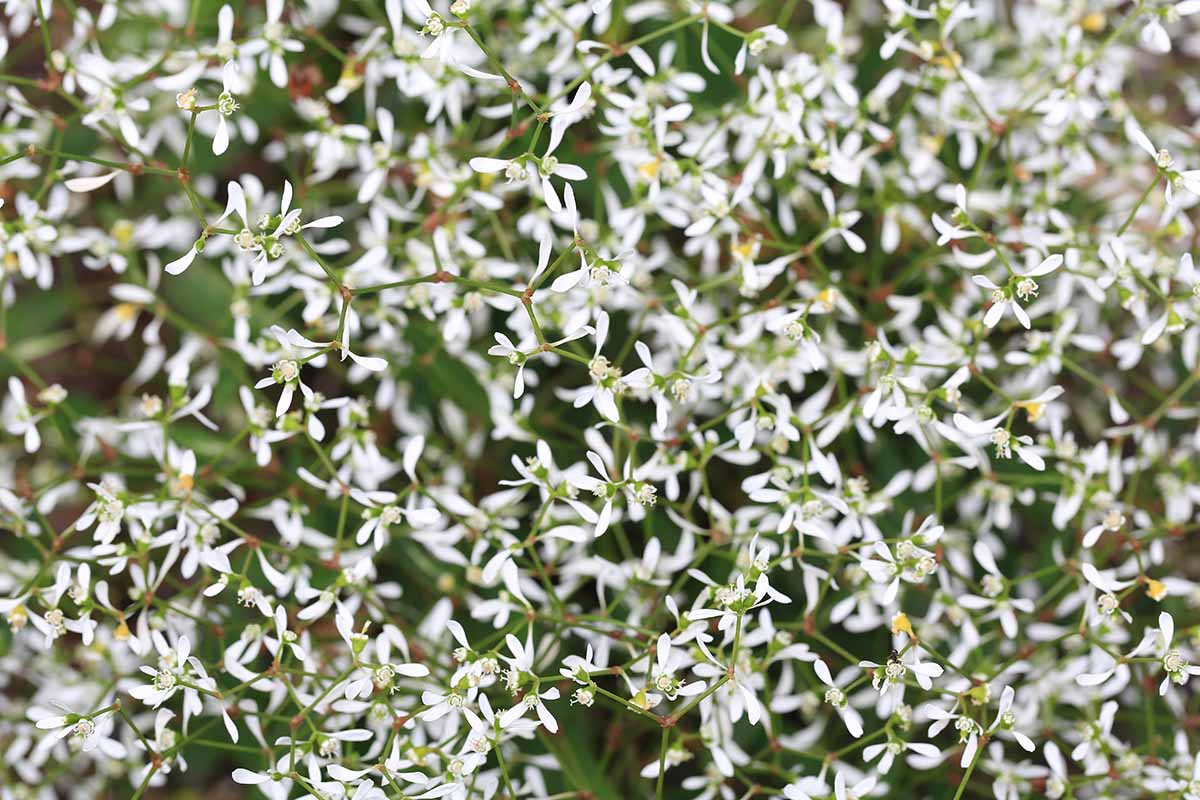
It almost resembles baby’s breath with its masses of petite bracts.
Diamond Frost is not frost tolerant and it should be grown as an annual outside of Zones 10 to 12.
Bring a four-pack of four-inch pots home from Home Depot and you’ll be enjoying the display in no time.
Cap-saintemariensis
This plant’s lengthy name comes from its home in Cap St. Marie in Madagascar.
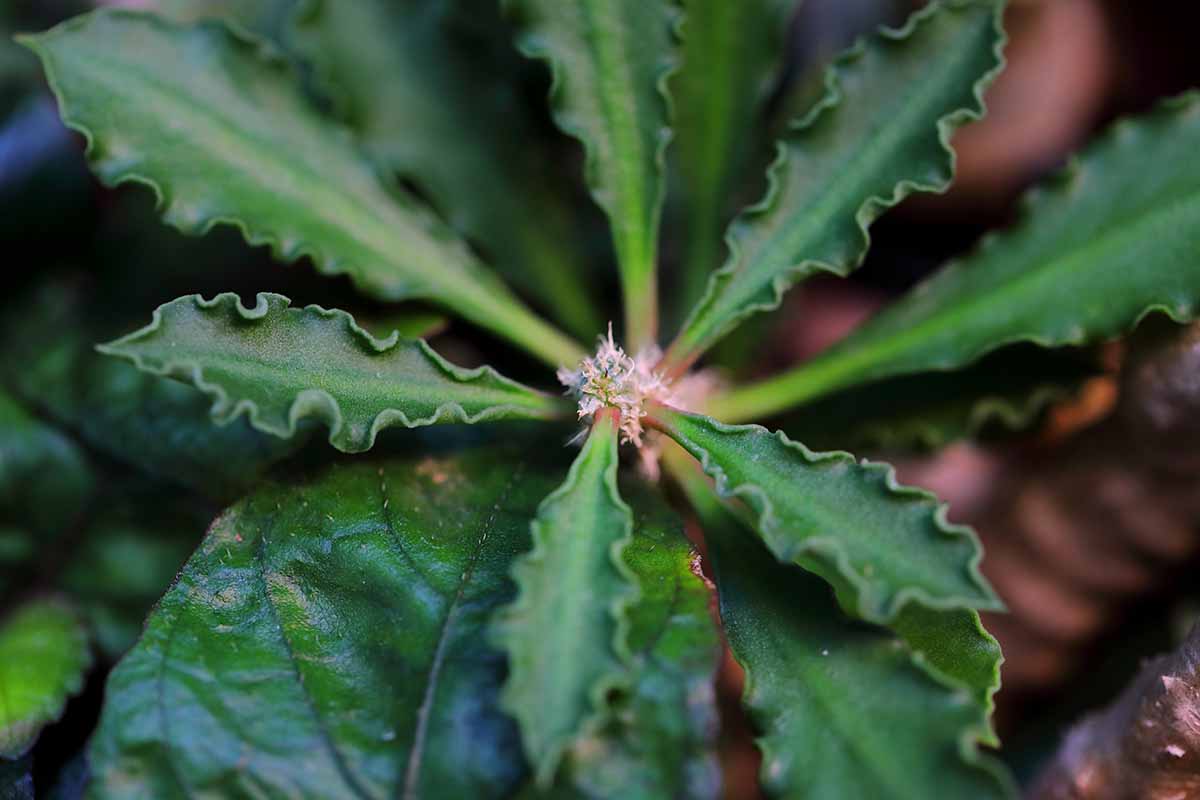
It has long stems with caps of elliptical green to maroon leaves that have intensely wavy margins. It grows up to 12 inches tall, and when it blooms, it sends out reddish-yellow flowers.
It would make an eye-catching addition to a rock garden or as a potted plant indoors. Just be sure it gets more than six hours of sun each day.
Marginata
Snow on the mountain (E. marginata) hails from the prairies and plains of the American Midwest. It’s a single-stemmed annual that grows up to three feet tall.
When it first emerges in the spring, it has solid green leaves. But as the summer progresses, the leaves develop a thick white edge. No wonder it’s also called “early snow.”

This is one euphorbia that grows well from seed. Pick up packages of 500 or 1,000 from Outside Pride at Amazon for growing in any USDA Hardiness Zone as an annual.
Milii
Christ plant, or crown of thorns, as E. milii is commonly known, is a colorful euphorbia with bright pink, red, or yellow flowers.

This herbaceous, deciduous perennial gets its name from the vicious black thorns that line the long stems.
Indigenous to the Middle East, some speculate that it was the plant used to create the crown of thorns in the story of Jesus Christ.
It grows to about six feet tall, though it stays smaller in cultivation, and also comes in a variegated cultivar known as ‘White Lightning.’
It can’t tolerate frost, so grow it as a houseplant or as a perennial in Zones 9 to 12. Hybrids of E. milli are some of the most abundant commercially, so keep an eye out.
Palustris
Remember how I promised you an exception to the sunny-and-dry rule? This is one.
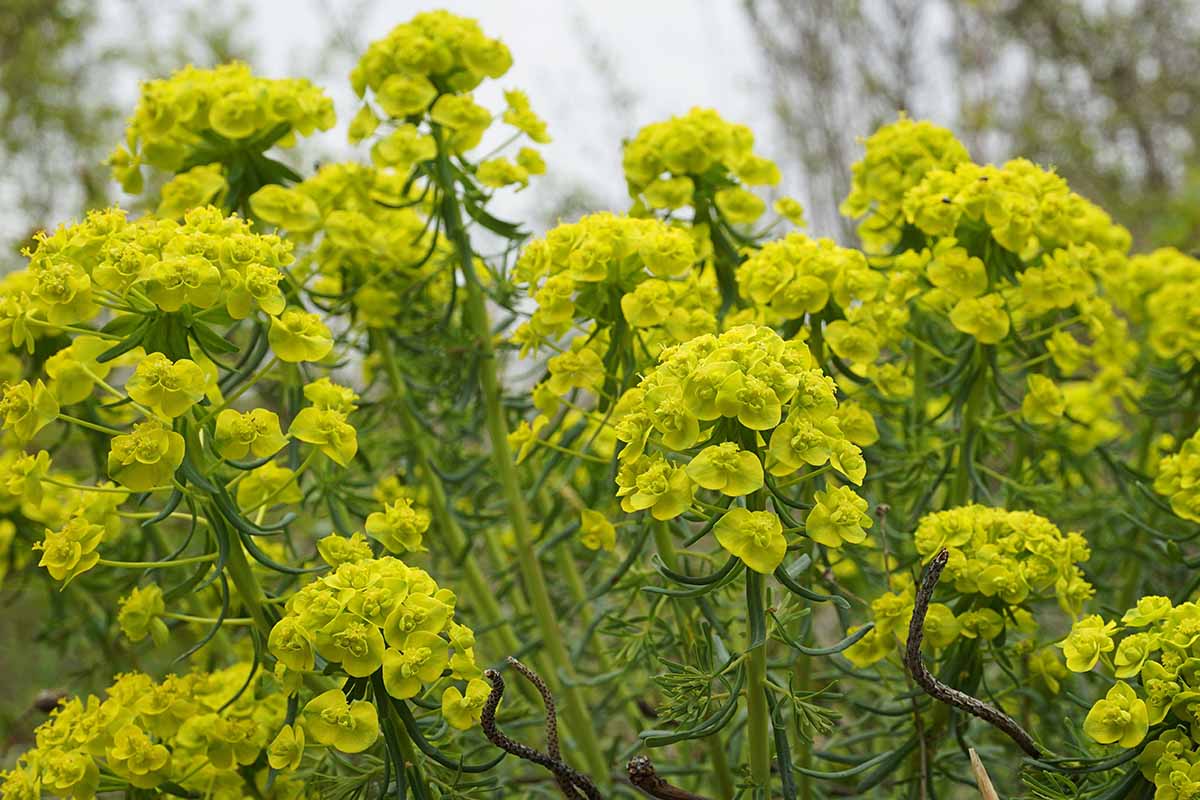
Marsh spurge (E. palustris) is a three-foot-tall herbaceous perennial with acid-yellow flower heads that emerge in the spring.
It needs moist soil and partial or full shade to thrive, and it’s hardy in Zones 5 to 9.
‘Walenburg’s Glorie’ has warmer yellow leaves with a white vein running down the middle.
Rigida
E. rigida (syn. E. biglandulosa) is commonly known as gopher plant or gopher spurge. It is an easy-care species, suitable for cultivation in Zones 7 to 10.
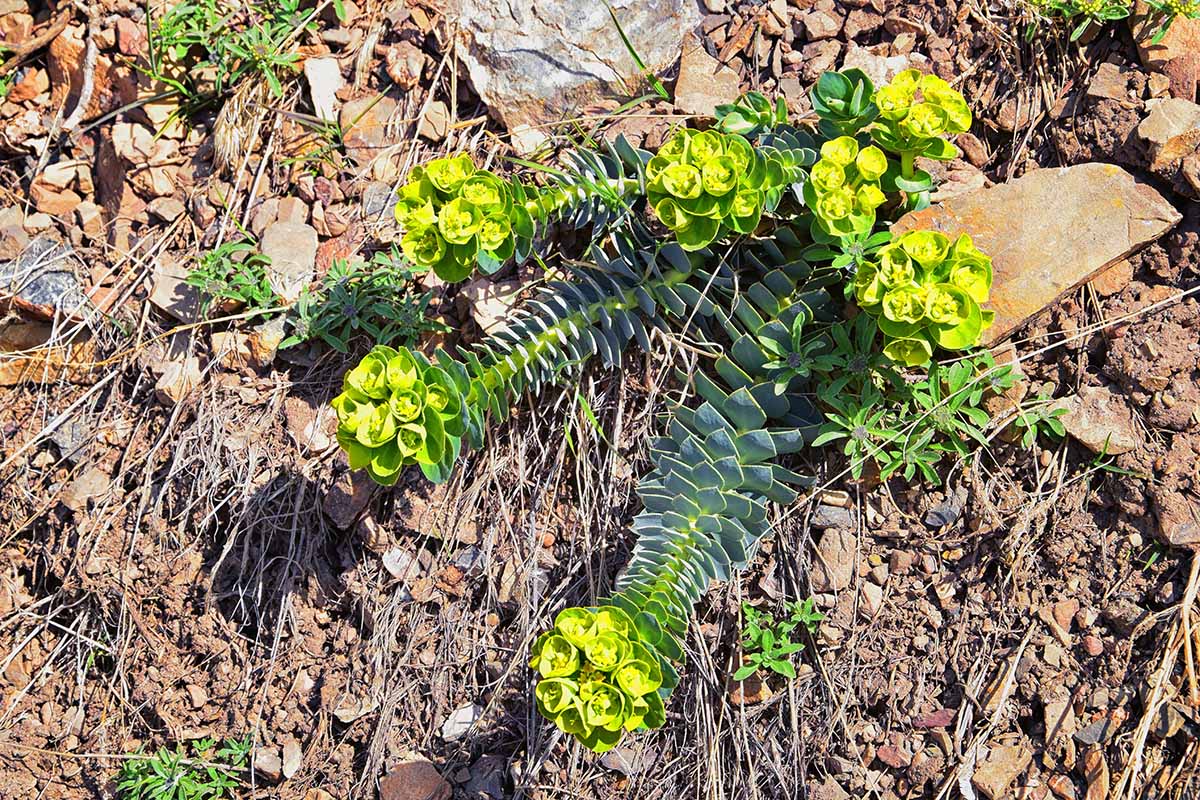
This evergreen has light green leaves, yellowish bracts, and tiny yellow flowers that appear in spring.
Gopher plant grows up to two feet tall, with a spread of three feet. This species is ideal for growing in rockeries, borders, and water-wise gardens.
You can learn more about growing gopher plants in our guide.
Ritchiei
E. ritchiei subs. marsabitensis, sometimes categorized as Monadenium ritchiei, is one unique succulent.
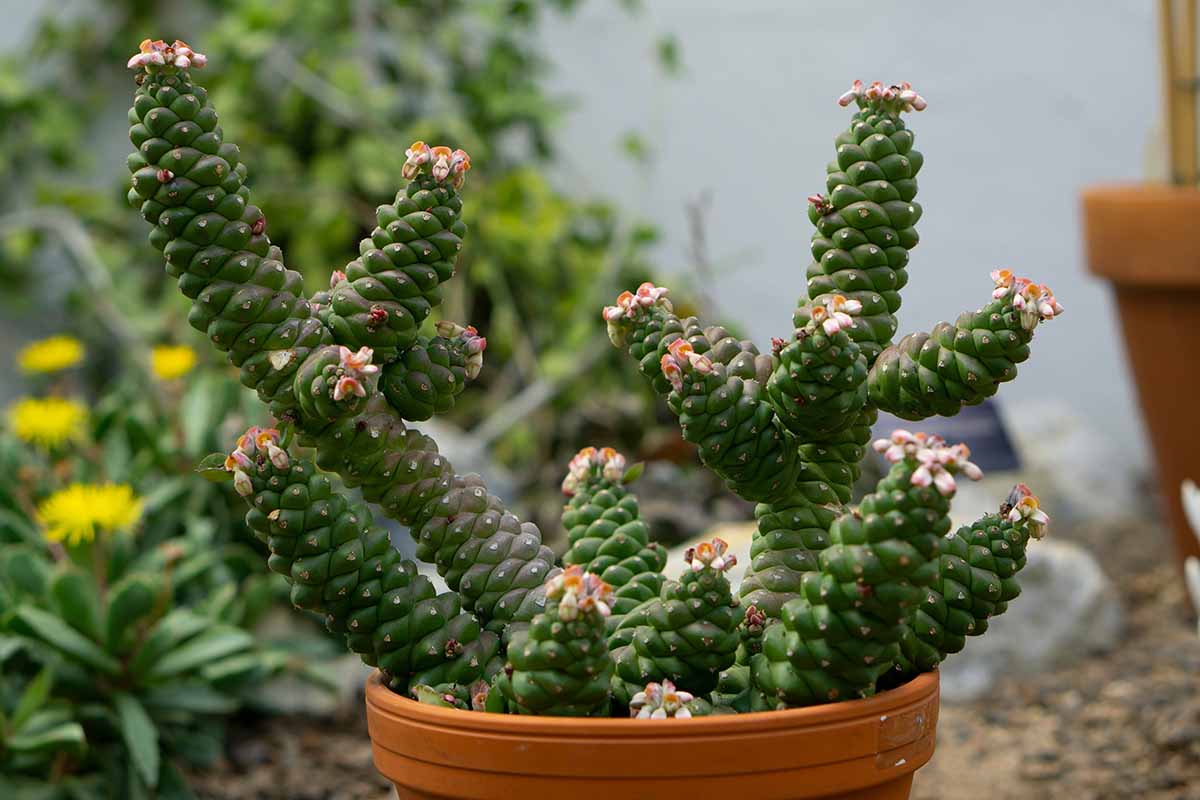
It has decumbent stems with prominent conical tubercles, which are modified petioles, from which the leaves emerge. All that’s just to say that they look like something from an alien planet.
The plant grows to a foot and a half tall and makes a good houseplant or annual, unless you live in Zones 10b to 12a where it will grow outdoors as a perennial.
Suzannae
A South African native, E. suzannae does a really good impression of a cactus. It grows in round clumps with pointy growths that look a lot like spines. They aren’t really, though.
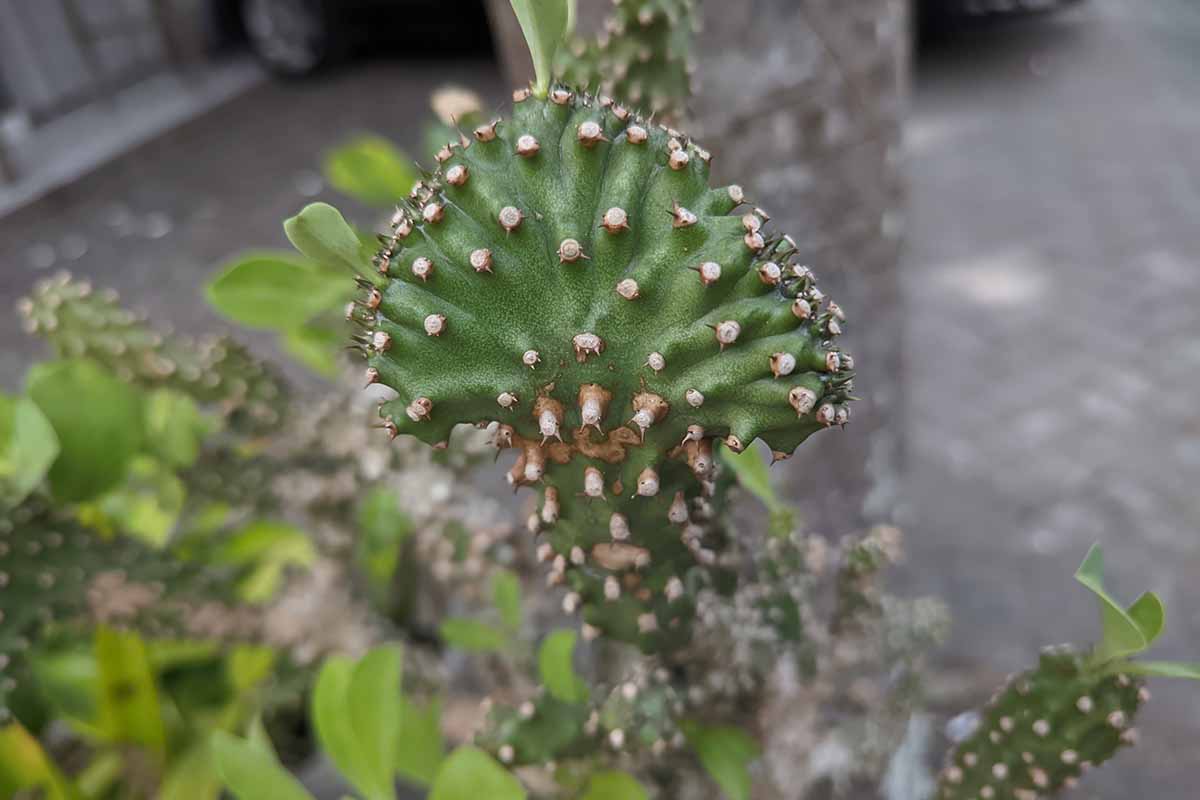
Topped with petite yellow blossoms in the summer, it’s an itty-bitty option that rarely grows more than four or five inches tall.
Don’t let it get cold, though. It’s only a perennial in Zones 10 to 12, and it makes a stellar houseplant otherwise.
Managing Pests and Disease
Herbivores avoid these plants like the plague. Their toxic sap is off-putting to most species.
Insects
As with herbivores, most pests avoid these plants, and I’ve never encountered any personally. But I’m told that pest problems do sometimes pop up.
Potato aphids (Macrosiphum euphorbiae) and mealybugs (family Pseudococcidae) are the two pests that you might encounter.
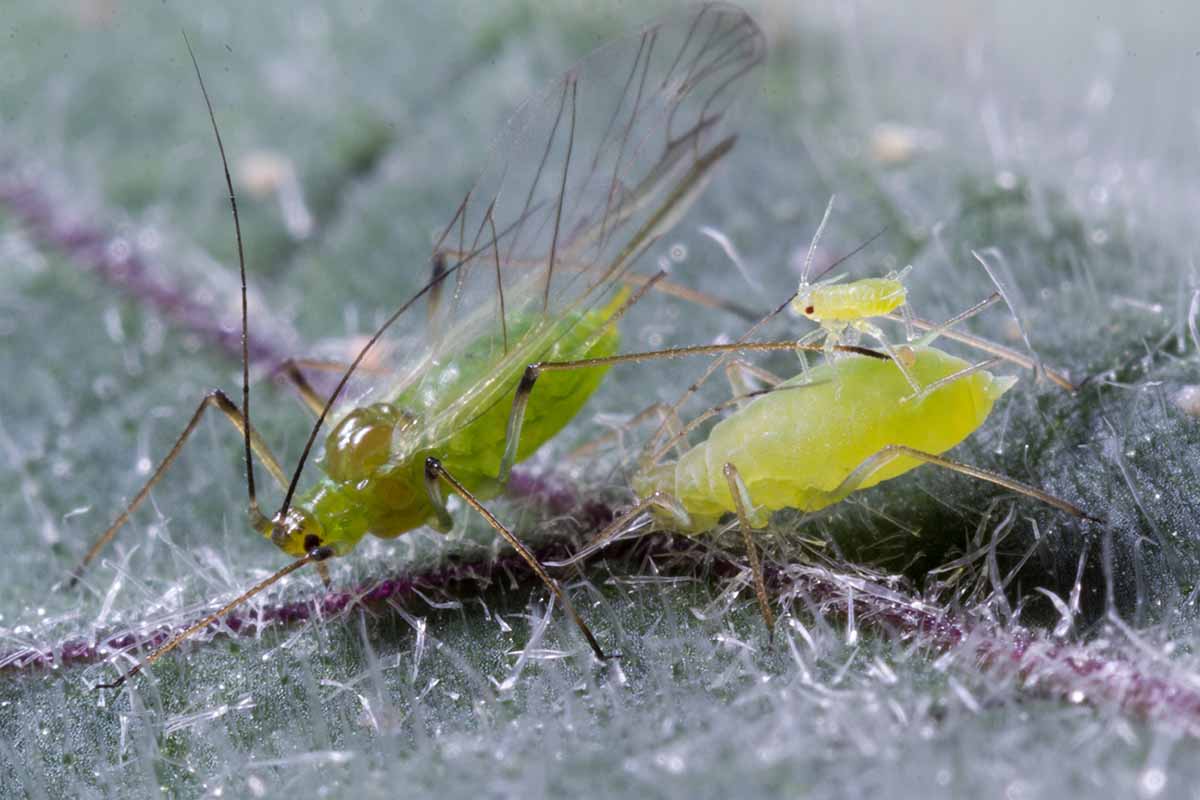
Both can be controlled using some pretty simple tactics, which include spraying plants with pesticides like insecticidal soap and manually removing the pests.
Disease
Euphorbia leaves have a waxy cuticle that protects them from most diseases. But sadly, it seems even the mighty spurge isn’t immune to one well-known garden foe: powdery mildew.
Plants growing in too little light or in wet locations are more prone to this disease, which is caused by Podosphaera euphorbiae (syn. Sphaerotheca euphorbiae).
If you’ve never encountered powdery mildew before, how did you get so lucky? For the rest of us, you know the drill.
It causes a powdery, flour-like coating to develop on the leaves of plants. It doesn’t typically cause much damage to euphorbia but if you want to treat it, read our guide to powdery mildew for tips.
Milk or copper sprays tend to be more than powerful enough to control this disease.
Best Uses
Depending on the species, Euphorbia plants make excellent houseplants, rock garden or xeric options, border plants, specimens, group plantings, or small shrubs.
For a plant that can thrive in challenging conditions, euphorbia is pretty hard to beat.
Quick Reference Growing Guide
| Plant Type: | Annual, biennial, perennial evergreen or deciduous herb | Flower/Foliage Color: | White, green, yellow, orange, pink, red/green, yellow, white |
| Native to: | Africa, the Americas, Australia, China, Europe, India, the Pacific Islands | Maintenance: | Low |
| Hardiness (USDA Zones): | 5-12, depending on species | Tolerance: | Drought, some frost |
| Bloom Time: | Spring, summer | Soil Type: | Sandy to loamy |
| Exposure: | Full sun to part shade | Soil pH: | 5.0-8.0 |
| Time to Maturity: | 6 months-5 years, depending on species | Soil Drainage: | Well-draining |
| Spacing: | 1 inch (seeds), 1 foot average depending on species (transplants) | Attracts: | Pollinators |
| Planting Depth: | Seeds twice as deep as their width, container plants as deep as original container | Companion Planting: | Succulents |
| Height: | 6 inches-100 feet | Avoid Planting With: | Water-loving plants like irises, canna lilies, ferns |
| Spread: | 6 inches-30 feet | Uses: | Containers, xeriscaping, rock gardens, borders, specimens, groupings |
| Growth Rate: | Moderate to fast | Family: | Euphorbiaceae |
| Water Needs: | Low to moderate | Genus: | Euphorbia |
| Common Pests and Disease: | Aphids, mealybugs; powdery mildew | Species: | Albomarginata, candelabrum, capsaintemariensis, cyanthorphora, esula, griffithii, horrida, marginata, milii, palustris, rigida, ritchiei, suzannae |
Versatile, Adaptable, Incredible Euphorbia
Who doesn’t love a plant that can adapt to those areas that other species just can’t survive in?
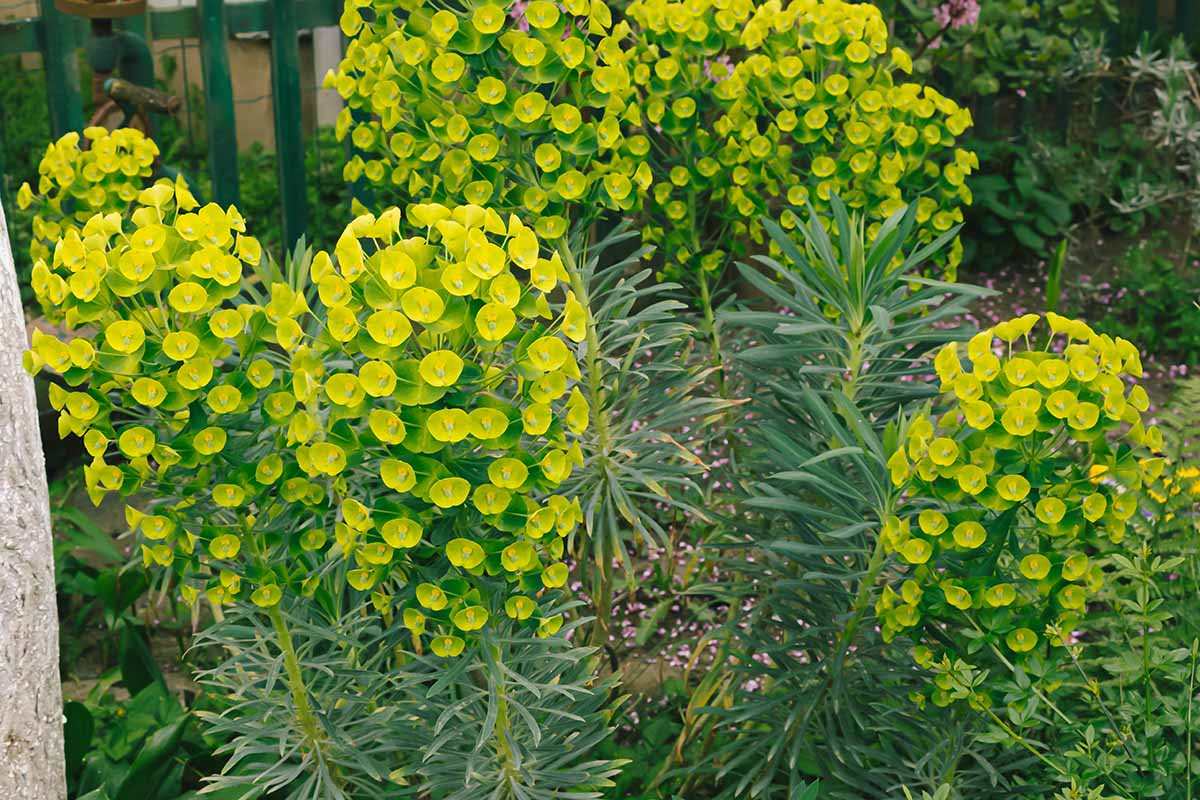
But this isn’t just any plant – the acid-green leaves on most species are truly incredible, and they stand out from most other plants.
Which one is calling your name, and how do you want to use it? Did we miss a favorite of yours that should be on this list? Let us know in the comments section below.
Looking for some tips on caring for your new additions? We have a few guides that might catch your eye. Check out these guides to growing succulents next:


